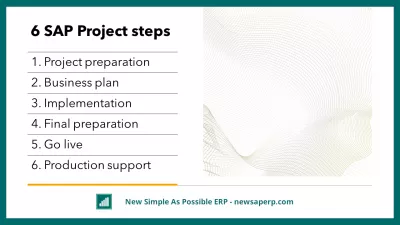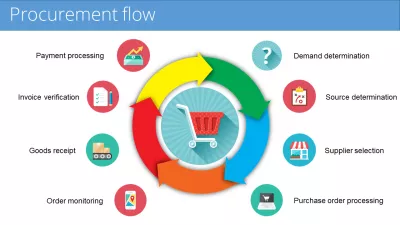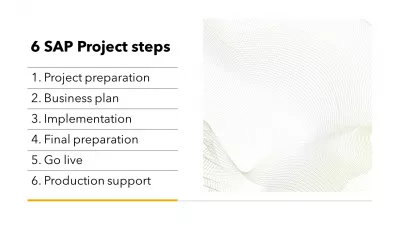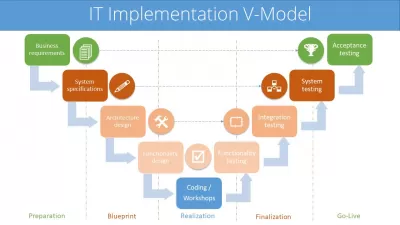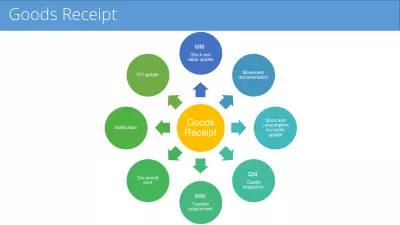Successful SAP Project Management: 6 Steps
- Successful SAP project management
- Successful SAP project management
- What Makes a Successful SAP Project Manager? What online courses should he take?
- What methods of EPR management work best?
- How to Ensure Successful Implementation of a SAP Project?
- 1. Project preparation
- 2. Business plan
- 3. Implementation
- 4. Final preparation
- 5. Go live
- 6. Production support.
- SAP PM: equipment maintenance and repair
- Frequently Asked Questions
Everything about a single automated SAP system and about achieving maximum efficiency about its implementation in production or in a company
Successful SAP project management
SAP is one unified automated system that is simply necessary in an enterprise to create one common information space and competently build a work plan.
The advantage of this system is that it has a whole bunch of different tools, and you can use them all at once, or by choosing only what is most needed.
In more understandable words, SAP is accounting and logistics in one bottle. With the help of this system, you can automate the hard work of an accountant, draw up the most visual salary schedules, and improve the logistics system at the enterprise.
Successful SAP project management
Many companies try to implement this system for one reason: long-term success in the market, expensive project cost, which is mistakenly assumed that SAP will work for people. And this mistake very often leads to a complete failure of the project.
SAP Management is a module that automates all project management processes, whether it is a single project or a project portfolio. Successful SAP implementation and effective project management with the help of tools for structuring, planning, visualization is simply necessary for a successful business.
In order for there to be a successful SAP project management, the company must understand itself:
- Have a clear strategic direction;
- Have well-defined business processes;
- Clear requirements.
Only if all these factors are present, the SAP project will be successfully implemented.
What Makes a Successful SAP Project Manager? What online courses should he take?
Naturally, in order to be a successful manager of this project, you need training, as in any other area without knowledge anywhere. Especially considering the fact that SAP projects are quite complex for non-professionals.
If we talk about training, the SAP team, through its partners, offers online training. It is convenient because you can study literally from anywhere in the world without additional costs and in a comfortable environment.
Sometimes training is free, but most often the price reaches about thirty thousand rubles. For this money, the student receives lectures, all kinds of webinars, and subsequently access to practical tasks.
The most important and well-known partners of the SAP project, providing such training:
- SAP Academic Competence Center
- Moscow State University of Economics, Statistics and Informatics (MESI)
- Training center at MSTU named after N. E. Bauman Specialist
- Single resource center for SAP projects - ExRP
After graduation, the specialist receives a certificate on a special letterhead, which will detail the course of training.
What methods of EPR management work best?
EPR system, in simple terms, stands for enterprise resource planning. Each company chooses such a system itself based on the direction of its activities. Naturally, this whole system is not free, but the investment is worth it, and everything pays off quickly enough. How?
If a company is very small, it has few employees and a relatively small amount of information, and the head of the company can track all this, for example, in paper form, then they most likely do not need such a system. But if the company is larger, more employees, more information, the leader sometimes has to be torn from multitasking. This is exactly the kind of company that needs EPR.
Of course, in such a project, a lot depends on the manager and his qualities. He must be well versed in both business and technology, only in this case it will be possible to bring changes to the company.
There is no specific list of methods for managing this system, but there are some points that are very important to pay attention to.
First, before starting a project, the scope of the project itself must be clearly defined. Otherwise, the endless project syndrome will turn out. It is necessary to follow a strictly outlined work plan, otherwise in the end it will turn out that something superfluous was added, and the important thing was forgotten.
Secondly, this is work with personnel, with all departments in which the project is supposed to be used. The manager himself will not be able to determine which interfaces are useful and which are not; this will require working with people from all possible departments.
Thirdly, even when the project is practically implemented, the corporate staff needs the help of a consultant. This is done so that people get used to the program faster and the work does not stand still.
How to Ensure Successful Implementation of a SAP Project?
There are 6 steps to ensure a successful project. Let's consider them in stages.
1. Project preparation
In this step, clear boundaries should be established with what work will be done and what not. This also includes drawing up a project plan, and here all the details are taken into account, up to whether the implementation of the system will affect the quality of products or services provided by the organization.
Additionally, the servers are prepared to be able to support the 3 landscape architecture that will be used during the whole SAP ERP project management, not only during the implementation process, but also after go-live during the whole SAP project lifecycle.
SAP Project Preparation Phase – Technosap2. Business plan
This is where the work with people begins. For the best understanding of the situation, it is best to convene a kickoff workshop and tell the project participants what is generally required of them and how it will all be implemented. You can clearly show an example as it is now in your company and how it will work in SAP. You also need to think about programs that will not be included in the system, but will run in parallel.
Planning an SAP project? Make sure of the business benefits first!3. Implementation
This step should be started when the entire analysis of the situation has been fully completed. At this stage, all the necessary information is entered into the system, from time to time it is necessary to test the new system to make sure that everything is going as it should, to fill in any gaps.
SAP implementation steps4. Final preparation
Here we are talking not only about the system itself, but also about people. Every employee of the company must be well trained in the new program, and the system itself must be fully tested. There should be no more gaps, they should be resolved before this stage. And if it happens that this whole system of people and technologies is not 100% ready, then it is categorically impossible to move on to the next stage, that is, the launch of the project.
Realization phase and final preparation phase? SAP Community5. Go live
If everything is in order with the previous step and you can start the system, then the turn of the Go live stage begins. This means that the old system, which was functioning in the company or in production, completely stops, there will be no business at all, all available data in the old system migrates to the new one.
How to go-live when the world becomes remote overnight?6. Production support.
When the entire system is up and running, support is still needed in case any gaps are suddenly revealed and a solution is needed.
Sap production support services – SlideShareFree infographic: SAP Project steps implementation
SAP PM: equipment maintenance and repair
Any plant has equipment, and it is very important to carry out maintenance and repair of this equipment in a timely manner. The SAP PM module will automate a bunch of processes associated with this task:
- This will include accounting for staff workload;
- Accounting and forecasting financial costs;
- Control and management of the equipment maintenance process;
- Scheduling of all kinds of equipment inspections and repair work, indicating their type and the resources necessary for this;
- Assessment of the technical condition of the equipment, taking into account the time of its operation, wear of possible parts and assemblies;
- Full display of the equipment maintenance history, as well as information on the repairs already carried out;
- Accounting for the number, types and composition of equipment.
Frequently Asked Questions
- What are the six steps for successful SAP project management?
- The six steps include thorough planning, clear scope definition, effective communication, stakeholder engagement, risk management, and continuous monitoring and control.
